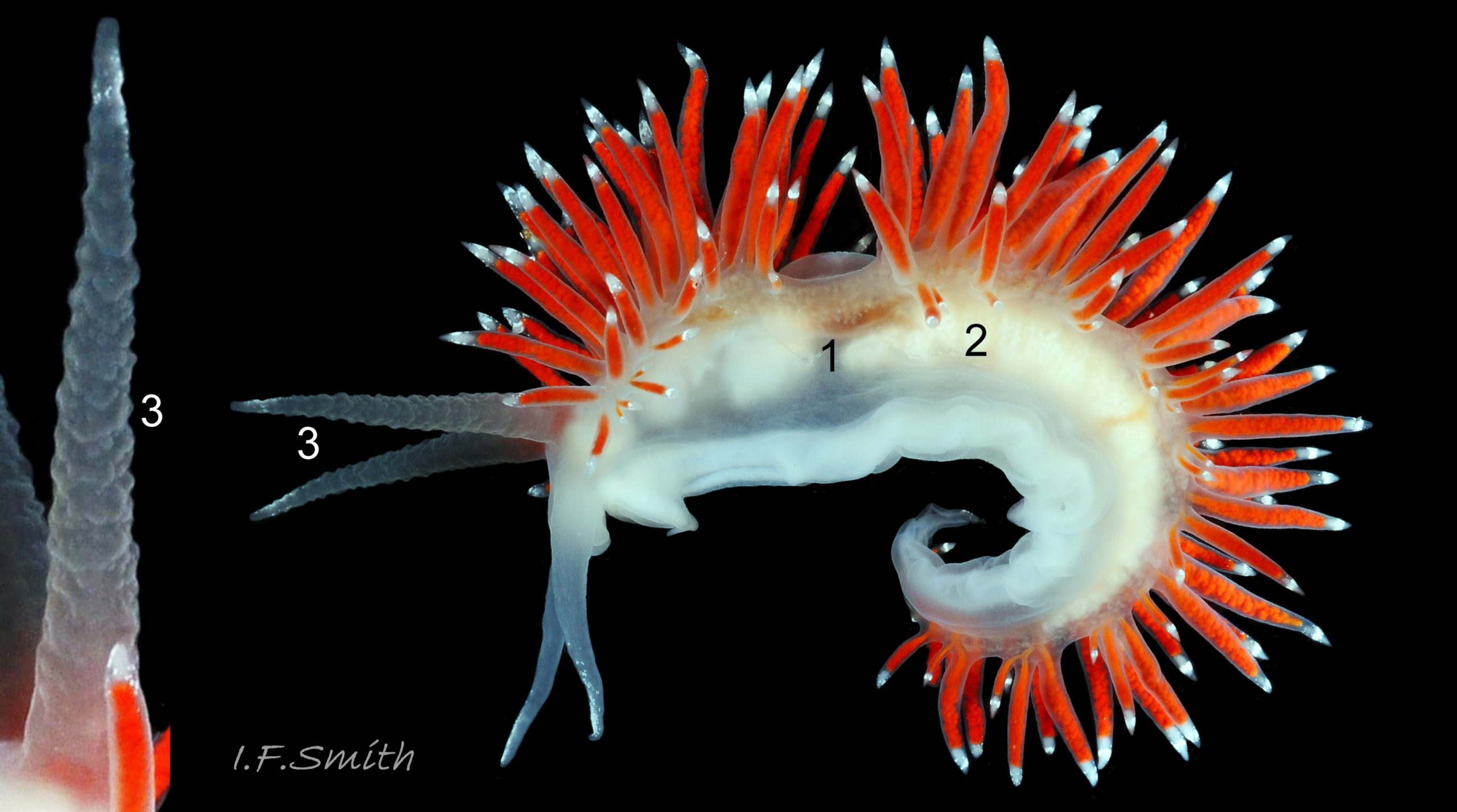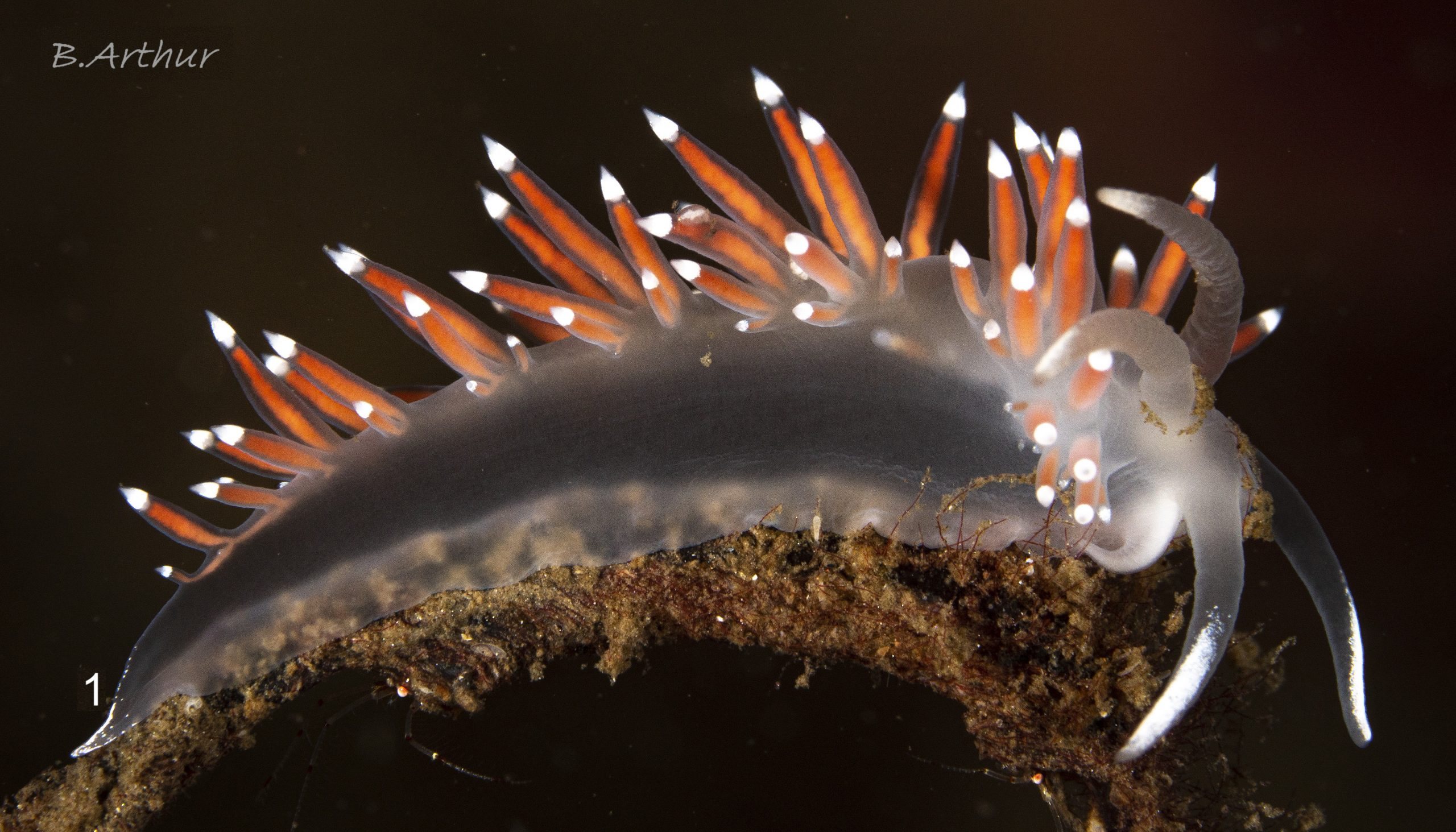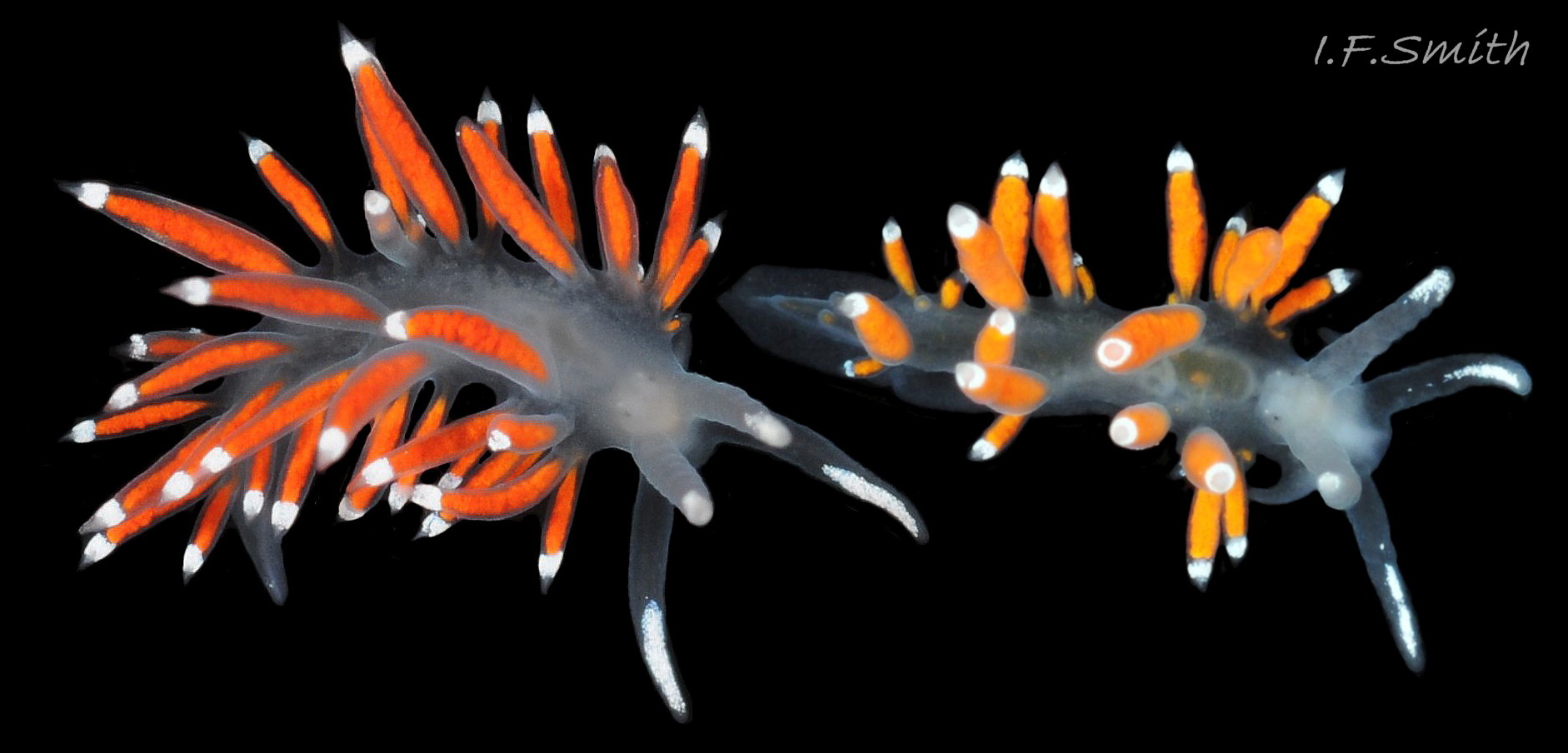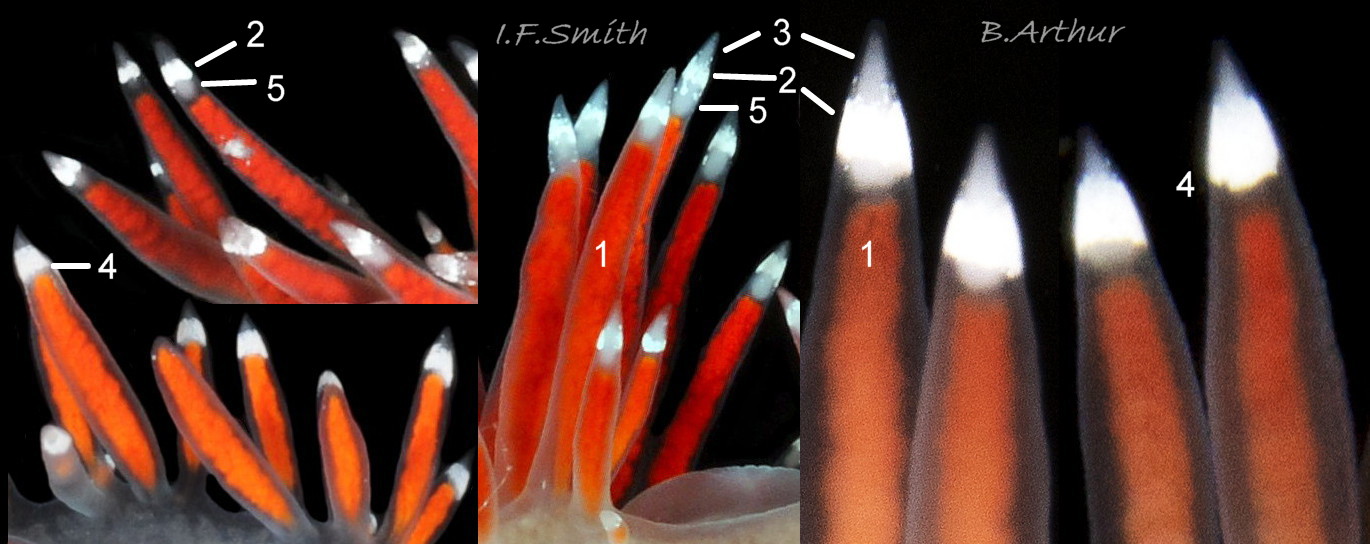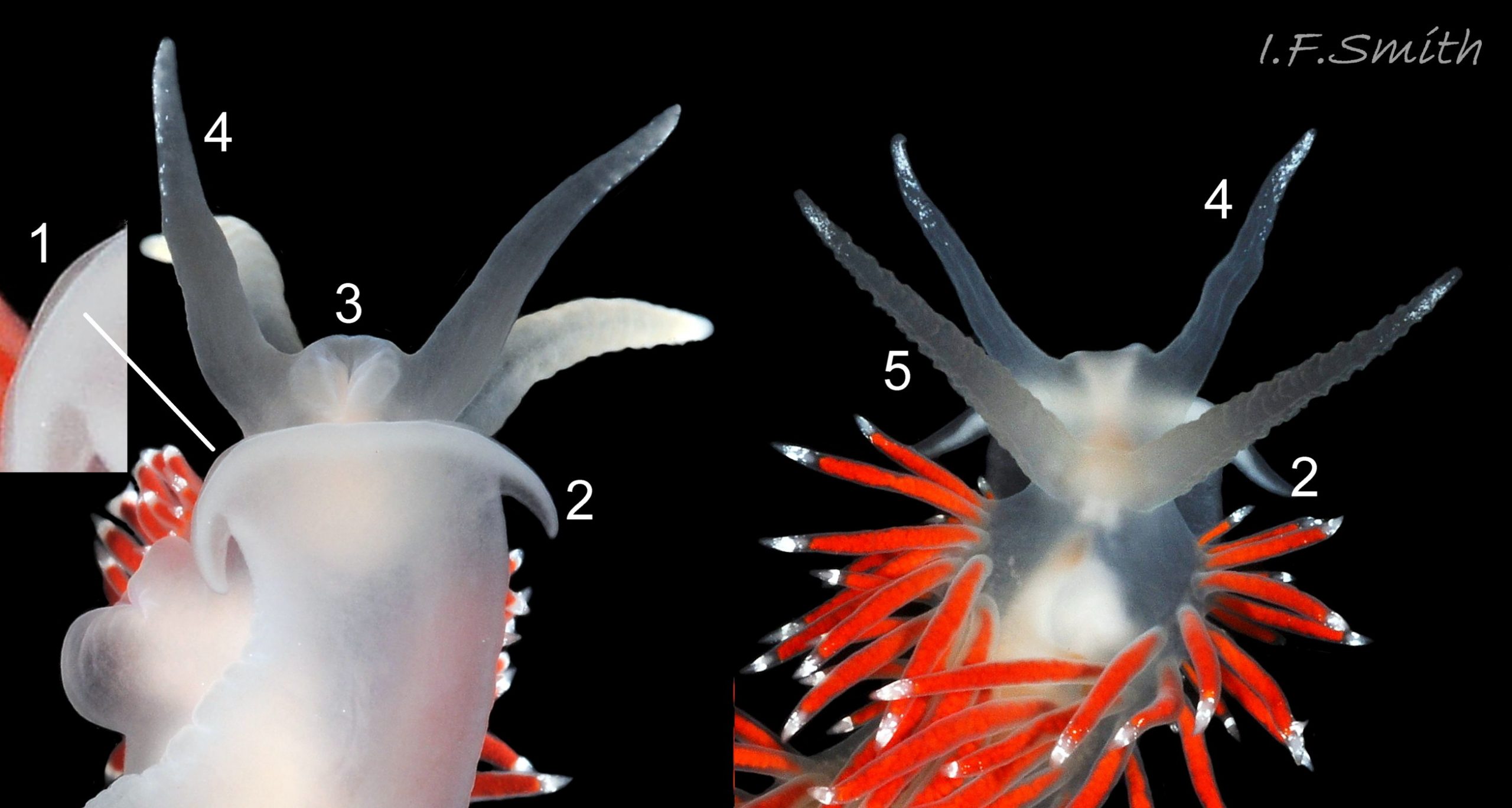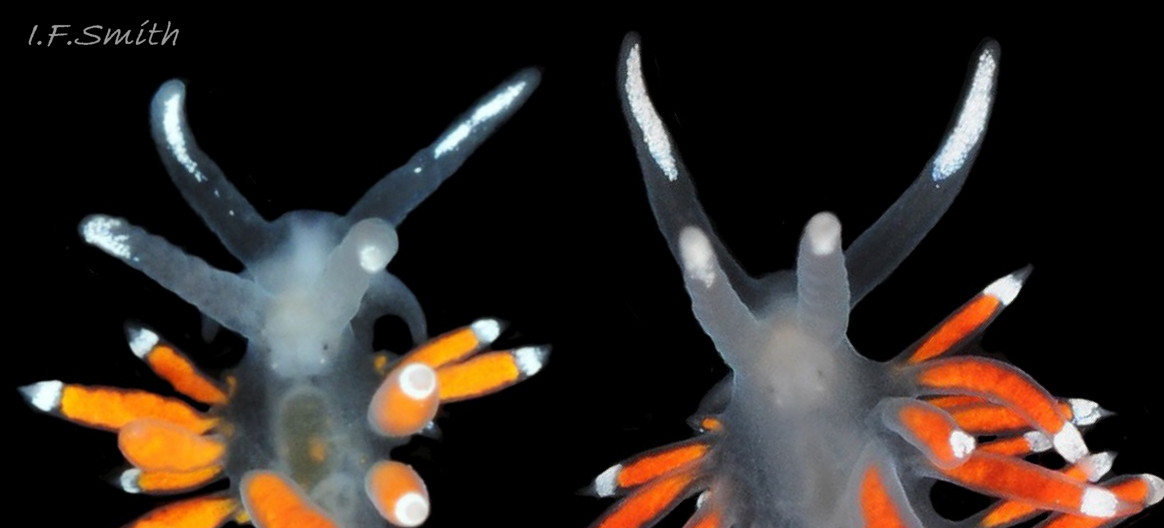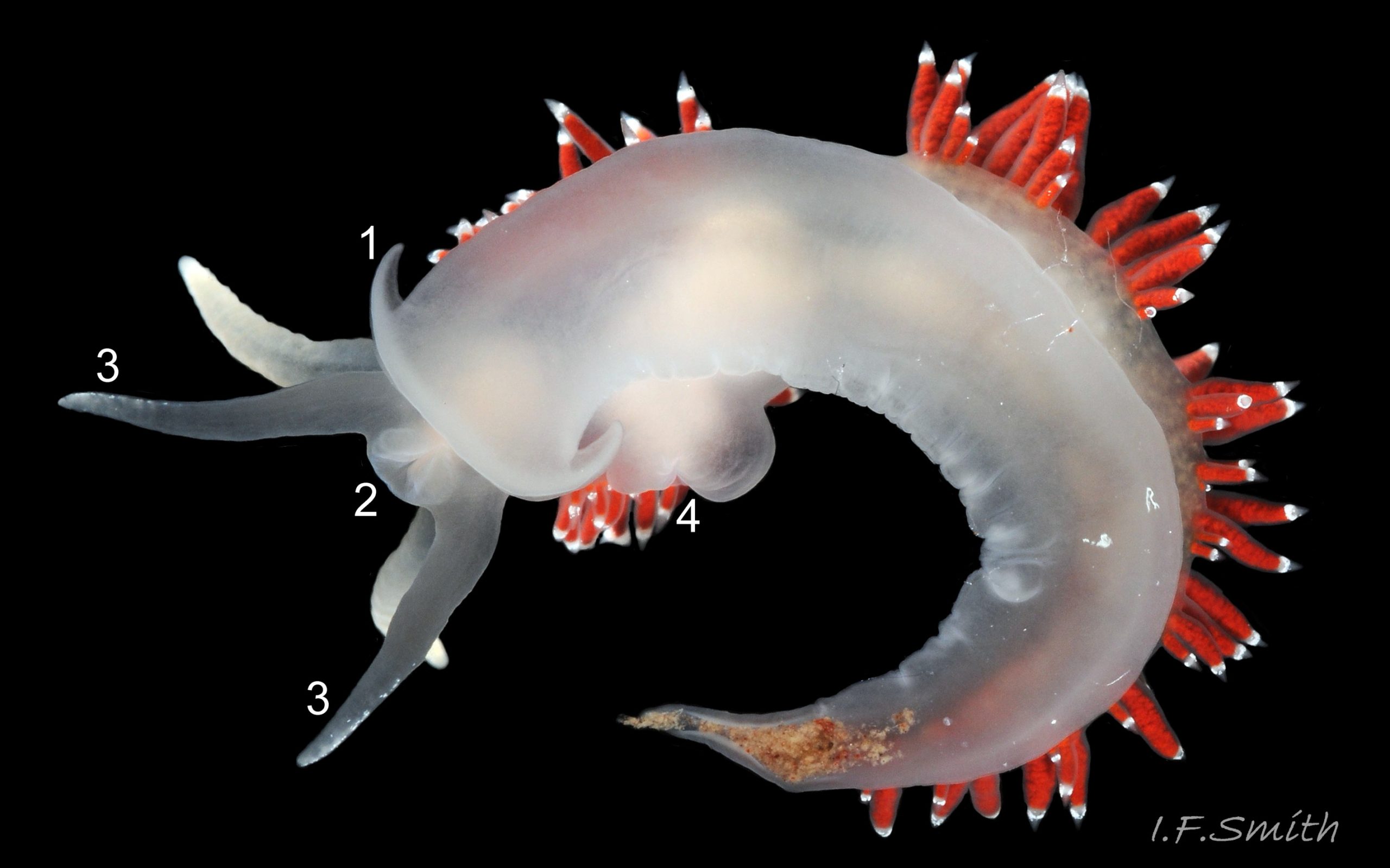Click image to enlarge with full caption. Main text below slider.
Coryphella browni Picton, 1980
Current taxonomy: World Register of Marine Species www.marinespecies.org/aphia.php?p=taxdetails&id=139980
Synonyms: Flabellina browni (Picton, 1980); Fjordia browni (Picton, 1980).
GLOSSARY BELOW
Description
Coryphella browni grows up to 30 mm, exceptionally 50 mm, long. The body is translucent white, revealing opaque, white ovotestes and viscera 01 Coryphella browni . The brown intestine-rectum is sometimes visible 06 Coryphella browni . The anus is below the second group of cerata on the right and there is a dorsal swelling over the pericardium 02 Coryphella browni . The male and female genital openings are often protruded below the first ceratal group on the animal’s right 02 Coryphella browni & 10 Coryphella browni . Small white opaque marks may form a discontinuous medial line from the rear cerata to the tip of the tail 03 Coryphella browni , often reduced to a few dots 04 Coryphella browni or absent 05 Coryphella browni .
The cerata are arranged in groups arising from slight ridges which do not continue across the intervening gaps 06 Coryphella browni . The integument of the cerata is transparent, colourless, revealing the bright red to brown internal digestive gland. The cerata have a substantial, wide, opaque white, subapical band of pigment with a translucent, pointed apex 07 Coryphella browni .
The rhinophores lack lamellae, but are often strongly wrinkled 01 Coryphella browni . They are translucent with variable amounts of opaque white surface pigment distally 04 Coryphella browni & 05 Coryphella browni .
The visible head consists of substantial outer lips, usually held as a ventrally slit circle, flanked by large, tapered, translucent oral tentacles with variable amounts of opaque white surface pigment distally 08 Coryphella browni . The small black internal eye is difficult to discern on adults, but may be visible to the rear of the rhinophores on the more translucent juveniles 09 Coryphella browni .
The foot is usually widest at the anterior and tapers steadily to a fine posterior point 10 Coryphella browni . The bilaminate anterior edge extends into distinct, usually curved, tapered propodial tentacles 08 Coryphella browni . The translucent, white sole faintly reveals some viscera.
Key identification features
Coryphella browni
1) Excluding appendages, the only surface pigment on the body is the discontinuous, white, medial line from the rear cerata to tip of the tail 03 Coryphella browni , often reduced to a few dots 04 Coryphella browni or absent 05 Coryphella browni .
2) Broad, white, subapical ring on cerata, but distinct pointed apex is translucent 07 Coryphella browni .
Similar species
Coryphella lineata (Lovén, 1846) 11 Coryphella browni and Coryphella chriskaugei (Korshunova, Martynov, Bakken, Evertsen, Fletcher, Mudianta, Saito, Lundin, Schrödl & Picton, 2017)
1) White lines run along dorsum and sides of body, and the full lengths of the rhinophores and oral tentacles.
2) White lines on cerata expand on C. lineata into a white cap with small translucent apex.
Coryphella gracilis (Alder & Hancock, 1844) 12 Coryphella browni
1) Excluding appendages, the only surface pigment on the body is the discontinuous, white, medial line, often reduced to a few dots or absent, from the rear cerata to tip of the tail.
2) Distal white ring on cerata fragmented and narrower than on C. browni.
Maximum size 15 mm. Round blobs of ovotestes visible in small specimens as it matures at a smaller size than larger species do.
Coryphella verrucosa rufibranchialis (G. Johnston, 1832) 13 Coryphella browni
1) Interrupted white dorsal line on body becomes continuous on tail.
2) Distal white ring on cerata fragmented and narrower than on C. browni.
Carronella pellucida (Alder & Hancock, 1843) 14 Coryphella browni
1) White dorsal line on tail.
2) Unbroken white pigment covers distal end, including apex, of cerata.
Habits and ecology
C. browni lives offshore and at LWS on rocky shores where strong currents favour its prey; Tubularia indivisa and, sometimes, Corymorpha nutans or Eudendrium.
Distribution and status
C. browni occurs from Iceland to Atlantic France. It may extend further; late (1980) recognition of the species makes re-examination of Iberian and Western Mediterranean specimens desirable GBIF map www.gbif.org/species/2292286 . It is common around Ireland and Britain where Tubularia occurs, but less common in the North Sea. UK distribution map species.nbnatlas.org/species/NHMSYS0021185577 .
Acknowledgements
For use of images I gratefully thank Billy Arthur, Nathan Jeffrey, Tim Nicholson and Poul Rasmussen. I thank Simon Taylor for providing specimens, and Bernard Picton for advice. Any errors or omissions are my responsibility.
References and links
Picton, B. E. (1980). A new species of Coryphella (Gastropoda: Opisthobranchia) from the British Isles. Irish Naturalists’ Journal. 20: 15-19. www.jstor.org/stable/25538360
Thompson, T.E. & Brown, G.H. 1984. Biology of opisthobranch molluscs 2. London, Ray Society.
Glossary
cerata = (sing. ceras) lobes on dorsum of aeolids and some other seaslugs.
distal = away from centre of body or from point of attachment.
integument = an enveloping layer, such as a skin, membrane or cuticle, of an organism or one of its parts.
lamellae = small plates on rhinophores.
LWS = low water spring tide, and level it falls to; two periods of a few days each month when tide falls lowest.
ovotestis = (pl. ovotestes) hermaphrodite organ serving as both ovary and testis.
pericardium = sac containing heart, visible behind rhinophores in translucent aeolid sea slugs.
metapodium = hind portion of the foot. (adj. metapodial).
pericardium = sac containing heart, sometimes visible as a raised mound behind rhinophores in aeolid sea slugs.
propodium = anterior portion of gastropod foot. (adj. propodial).
rhinophores = chemo-receptor tentacles on top of head of nudibranch.
